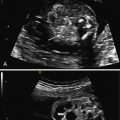Abstract
Numerous pathologic processes can alter the development of the fetal intestinal tract. Cystic or echogenic fetal intraabdominal findings warrant detailed study of the gastrointestinal tract. In this chapter, we describe bowel disorders that can be diagnosed by prenatal ultrasound, starting in sequence from the proximal to the distal segments of the gastrointestinal tract and including esophageal obstruction, gastric obstruction, duodenal obstruction, jejunal obstruction, imperforate anus, Hirschsprung disease, volvulus, echogenic bowel, and meconium ileus. The manifestations on imaging and typical signs in ultrasound and, where possible, on magnetic resonance imaging, are shown. We present the typical differential diagnoses and give a synopsis of the treatment options.
Keywords
intestinal obstruction, intraabdominal cysts, esophageal obstruction, gastric obstruction, duodenal obstruction, jejunal obstruction, imperforate anus, Hirschsprung disease, volvulus, echogenic bowel, meconium ileus
Introduction
The fetal intestinal tract can be altered by numerous pathologic processes. Typical ultrasound (US) findings of bowel obstruction are dilated bowel loops in the fetal abdomen proximal to the obstruction. Although large bowel dilatation occasionally can be observed, most cases of bowel dilatation are in the small intestine. Early diagnosis is possible for some proximal obstructions, such as duodenal atresia and esophageal atresia. In this chapter, we describe bowel disorders that can be diagnosed by prenatal US in anatomic sequence from the proximal to the distal segments of the gastrointestinal (GI) tract.
Esophageal Obstruction
Definition
Esophageal obstruction is a malformation in which the esophagus is interrupted and forms a blind-ending pouch rather than connecting normally to the stomach. The interrupted esophagus may or may not communicate with the trachea, forming different types of trache-esophageal fistulae (TEFs).
Prevalence and Epidemiology
The incidence is between 1 : 3000 and 1 : 4000 live births. Males are slightly more often affected than females.
Etiology and Pathophysiology
The etiologies include genetic and environmental factors. Esophageal obstruction with or without TEF results from incomplete division by the tracheoesophageal septum of the foregut into the ventral respiratory portion and the dorsal digestive portion. This process is normally completed by 8 weeks’ gestation. The most common variation is a proximal esophageal obstruction with a distal TEF, found in 86% of affected cases. Isolated esophageal atresia (upper and lower pouch esophageal obstruction) accounts for 7% to 8% of cases. The pathologic classification of esophageal malformations according to Gross is shown in Table 26.1 .
| Type | Name(s) | Description |
|---|---|---|
| A | “Long gap,” “pure” or “isolated” esophageal atresia | Esophageal atresia without fistula; characterized by the presence of a “gap” between the two esophageal blind pouches |
| B | Esophageal atresia with proximal TEF | Esophageal atresia where the upper esophageal pouch connects abnormally to the trachea (fistula); lower esophageal pouch ends blindly |
| C | Esophageal atresia with distal TEF | Esophageal atresia where the lower esophageal pouch connects abnormally with the trachea (fistula); upper esophageal pouch ends blindly |
| D | Esophageal atresia with both proximal and distal TEFs (two TEFs) | Esophageal atresia where the upper and lower esophageal pouches make an abnormal connection with the trachea in two separate, isolated places; upper esophageal atresia also still ends in a blind pouch |
| E | TEF only with no esophageal atresia plus blind pouch over esophageal atresia | Rare form of esophageal atresia with esophagus fully intact and capable of normal functions, but there is an abnormal connection between the esophagus and the trachea, called a fistula |
| F | Esophageal stenosis; also known as esophageal stricture | Rare form of esophageal atresia with esophagus fully intact and connected to the stomach, but the esophagus gradually narrows, causing food and saliva to become “caught” in the esophagus; this type occasionally can go undiagnosed until adulthood |
Manifestations of Disease
Clinical Presentation
Postnatal signs of esophageal atresia are respiratory distress, excessive salivation, “blowing bubbles,” and feeding difficulties.
Imaging Technique and Findings
Ultrasound.
Prenatal detection of esophageal obstruction is difficult; a suspicious prenatal US scan may show both polyhydramnios and a small or invisible fetal stomach ( Figs. 26.1 and 26.2 ). The reported sensitivity of detecting esophageal obstruction with US ranges from 24% to 42%. Polyhydramnios combined with a small or invisible stomach increases the positive predictive value to 39% to 56%. This combination lacks specificity, because amniotic fluid may flow into the stomach through a TEF. Because polyhydramnios usually does not occur before 20 weeks’ gestation, the diagnosis of esophageal obstruction is often made later. Efforts to improve the detection rate have focused on demonstration on US or magnetic resonance imaging (MRI) of an esophageal pouch, representing the dilatation of the blind-ending upper esophagus, which may be a transient finding. High-resolution US can sometimes visualize the fetal esophagus between the heart and the aorta. Esophageal obstruction is often associated with intrauterine growth restriction, a combination suggestive of syndromic association.

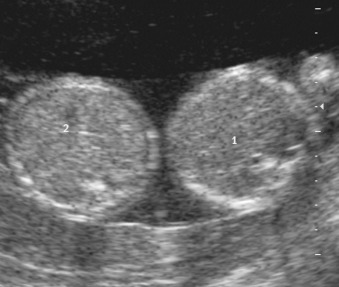
Magnetic Resonance Imaging.
On MRI, a TEF postnatally appears as a linear hypointense structure between the trachea and the esophagus, typically about 1 cm above the carina. Postnatal MRI can show air between the trachea and the esophagus, caused by an E-type TEF, which is beneficial with no need for swallowing during the study and without risk of aspiration as in a contrast work-up that is otherwise required.
Absent or very small stomach in combination with polyhydramnios
Differential Diagnosis From Imaging Findings
Lack of visualization of a fluid-filled stomach in the abdomen also occurs in diaphragmatic hernia, cleft lip/palate, arthrogryposis, twin-to-twin transfusion syndrome, trisomy 18, renal agenesis, and central nervous system disorders with impairment of swallowing ( Fig. 26.3 ), and in normal fetuses, although only transiently. Of infants with esophageal obstruction diagnosed postnatally, 6% to 10% have chromosomal abnormalities or genetic syndromes. Associated malformations are found in 50% to 70% and include GI (28%), cardiac (24%), genitourinary (13%), musculoskeletal (11%), central nervous system (7%), facial anomalies (6%), and other anomalies (12%). In about 10% of cases, esophageal obstruction is part of the VACTERL ( v ertebral, a nal, c ardiac, t racheal, e sophageal, r enal, and l imb anomalies) association, which is defined as esophageal obstruction (tracheoesophageal fistula) associated with at least two anomalies affecting the other listed regions.

Synopsis of Treatment Options
The prognosis of esophageal obstruction has improved because of better diagnostic techniques and preoperative and postoperative care. Mortality rates are related to additional congenital malformations and prematurity. In one study, children with esophageal obstruction diagnosed prenatally were born 2 weeks earlier than children with esophageal obstruction diagnosed postnatally (36.4 weeks versus 38.2 weeks; P = . 02), had a higher mortality (30% versus 12%; P = .05), and had more associated anomalies (80% versus 59%; P = . 04). Morbidity largely results from postoperative complications, structural abnormalities of the airways, and the presence of additional congenital anomalies. Morbidity in survivors is independent of the time of diagnosis and of the presence of associated anomalies. Other investigators reported a perinatal and infant mortality rate of about 22% ; 82% of the survivors underwent primary surgery, with a postoperative mortality rate of 9%. The prognosis of isolated esophageal obstruction is generally good.
Gastric Obstruction
Definition
Although pyloric stenosis is a relatively frequent finding after birth, gastric outlet obstruction rarely manifests in fetuses.
Prevalence and Epidemiology
Gastric outlet obstruction or pyloric stenosis is a rare condition representing 1% of all fetal GI obstructions. Congenital gastric outlet obstruction is commonly found as an isolated anomaly with an excellent prognosis.
Etiology and Pathophysiology
The etiology of pyloric stenosis is not known. The theory of a congenital inability of the pyloric sphincter to relax with subsequent hypertrophy of the pyloric musculature proximal to the sphincter forming the pyloric tumor was supported in independent studies, showing degenerated cells of the myenteric plexus in the pylorus.
Manifestations of Disease
Clinical Presentation
Projectile vomiting is present at birth or shortly after when the infant attempts to feed.
Imaging Technique and Findings
Ultrasound.
Prenatal diagnosis is rare but can be made mostly in the third trimester in cases with a combination of polyhydramnios and dilated stomach. Difficulties in prenatal detection are caused by physiologic variations of the fetal stomach size and the inconsistent, late development of polyhydramnios, which has been reported in only 50% of cases.
Differential Diagnosis From Imaging Findings
In about half of cases of gastric obstruction, associated anomalies have been described, including other intestinal anomalies and epidermolysis bullosa. Antral pyloric membranes, consisting of two layers of mucosa with one layer of submucosa in between, usually occur 1- to 7-cm proximal to the pylorus. On radiographs, a thin linear filling defect is seen, usually 2 to 3 mm in thickness and running perpendicular to the long axis of the antrum and 2- to 3-cm proximal to the pylorus, and a “double bulb” deformity with barium in the bulb and in the pyloric channel distal to the web is sometimes observed. Infants with antral webs may develop postprandial vomiting as thicker foods are added to the diet; however, nonobstructive webs are usually completely asymptomatic unless a large object, such as a foreign body, is swallowed.
Synopsis of Treatment Options
The surgical treatment for a pyloric membrane is a simple excision of the web, in some cases, in combination with laparoscopic pyloroplasty. Early diagnosis and treatment are important because the main causes of death in isolated cases are infectious complications or associated anomalies.
Duodenal Obstruction
Definition
Duodenal obstruction or duodenal atresia is a complete or partial obstruction of the duodenum.
Prevalence and Epidemiology
Duodenal atresia affects 1 : 5000 to 1 : 10,000 live births.
Etiology and Pathophysiology
Typically, 80% of the obstruction is distal to the ampulla of Vater and 20% proximal, and is usually a blind-end atresia that interrupts the duodenal lumen. One theory to explain duodenal atresia is failure to recanalize the duodenal lumen after being in a temporary solid state during early embryologic development; other authors have suggested an impairment of angiogenesis during gut development. Duodenal obstruction occurs more commonly in fetuses with trisomy 21 (30%) and is associated with other structural malformations (20%). In about 20% of patients, duodenal obstructions are associated with an annular pancreas, a ring of pancreatic tissue encircling the distal portion of the duodenum ; another suggests that the annular pancreas does not have a role in the genesis of the lesion but rather is a consequence of a common developmental field defect.
Manifestations of Disease
Clinical Presentation
Vomiting is the prevailing symptom of duodenal obstruction and may occur on the first day of life. The vomitus is bilious; the infant vomits feedings, loses weight, and is restless and irritable. Other symptoms include difficulty breathing, excessive salivation and drooling, a palpable mass in the abdomen, jaundice, and lethargy.
Imaging Technique and Findings
Ultrasound.
Duodenal atresia is typically diagnosed after 20 weeks’ gestation but can be found in the first trimester. Duodenal atresia is seen on US as a typical “double-bubble” sign, representing a fluid-filled stomach and proximal duodenum separated by a narrowing at the site of the pylorus that is much wider than normal and crossed by back-and-forth peristalsis of intestinal fluid. Rarely, a double-bubble sign can be seen in duodenal duplication, mimicking duodenal atresia ( Fig. 26.4 ). A C -shaped loop of dilated bowel may occur in combination with esophageal atresia ( Fig. 26.5 ). The increased amount of amniotic fluid in the stomach is related to the obstruction, despite regurgitation; this results in a characteristic C -shaped fluid collection in the upper fetal abdomen. Polyhydramnios occurs in the third trimester in virtually all cases of duodenal atresia.
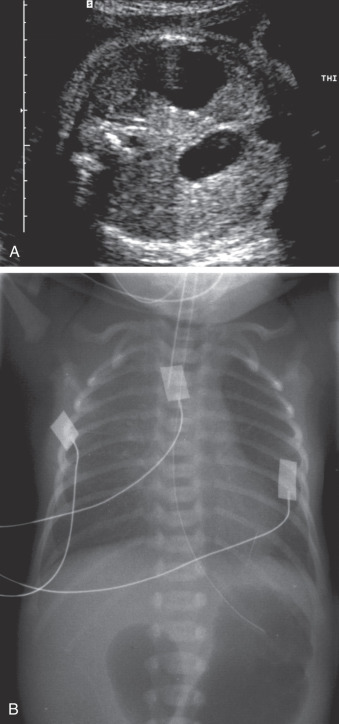

Magnetic Resonance Imaging.
On MRI, the signal intensity differences of the dilated bowel may provide information in addition to US findings in identifying the site of the obstruction. The proximal small bowel appears hyperintense on single shot fast spin echo (SSFSE) sequence and hypointense on T1-weighted fast spin echo (FSE) sequence. In contrast, the distal small bowel and colon appear intermediate to hypointense on SSFSE sequence and hyperintense on T1-weighted FSE sequence. Hyperintense bowel dilatation on SSFSE sequence suggests jejunal atresia, and bowel dilatation of intermediate intensity on SSFSE sequence and hyperintensity on T1-weighted FSE sequence suggests distal ileal atresia.
Typical double-bubble sign on US, representing a fluid-filled stomach and proximal duodenum.
Differential Diagnosis From Imaging Findings
Visualization of a pseudo–double bubble in an oblique plane of the fetal trunk as a consequence of a prominent incisura angularis of the stomach or a peristaltic wave of the stomach can be mistaken for duodenal atresia. To avoid this error, the abdomen should be scanned repeatedly in a transverse plane.
Synopsis of Treatment Options
Because significant fluid and electrolyte imbalances develop in neonates with duodenal atresia soon after birth, surgical bypass with a duodeno-duodenostomy or gastro-jejunostomy should be performed as soon as possible. Prenatal diagnosis of duodenal obstruction provides an opportunity for a delivery in an appropriate setting and reduces morbidity and hospitalization time. The overall survival rate is 57%.
Jejunal Obstruction
Definition
Jejuno-ileal atresia and stenosis are among the most common causes of neonatal intestinal obstruction. Atresia is a complete obstruction of the lumen of the bowel and is more common than stenosis.
Prevalence and Epidemiology
The jejunum and ileum account for 39% of intestinal atresias, with an incidence of 1 : 3000 to 1 : 5000 live births.
Etiology and Pathophysiology
Jejunal and ileal atresias may result from incomplete embryonic recanalization, but most cases are thought to result from intestinal vascular impairment during embryologic development. An inadequate blood supply may be the primary cause or secondary to associated disease such as gastroschisis or volvulus. Jejunal and ileal obstruction can be divided into five types according to Grosfeld, representing a spectrum of severity from a simple web to full atresia with loss of bowel length. Obstruction occurs in the proximal jejunum in 31%, the distal jejunum in 20%, the proximal ileum in 13%, and the distal ileum in 36% of cases. In about 6% of cases multiple atretic sites are present.
Manifestations of Disease
Clinical Presentation
The neonatal symptoms of jejunal atresia depend on how long the condition is left untreated. Classic symptoms include failure to tolerate feedings, nausea and vomiting, intermittent abdominal pain, and sometimes abdominal distention.
Imaging Technique and Findings
Ultrasound.
Jejunal and ileal atresias are diagnosed by prenatal US typically in the third trimester. The diagnosis is challenging, and a recent review demonstrated a wide range in sensitivity and specificity. Dilated jejunal and ileal bowel segments proximal to the site of atresia are rarely diagnosed before 24 weeks’ gestation. Follow-up US examinations for suspected intestinal atresia should be performed at 28 to 32 weeks’ gestation. Polyhydramnios is a common associated finding in small bowel obstruction during the third trimester and appears to be more likely with proximal atresia ( Fig. 26.6 ) ; its presence in combination with dilated bowel loops is associated with more severe obstruction.
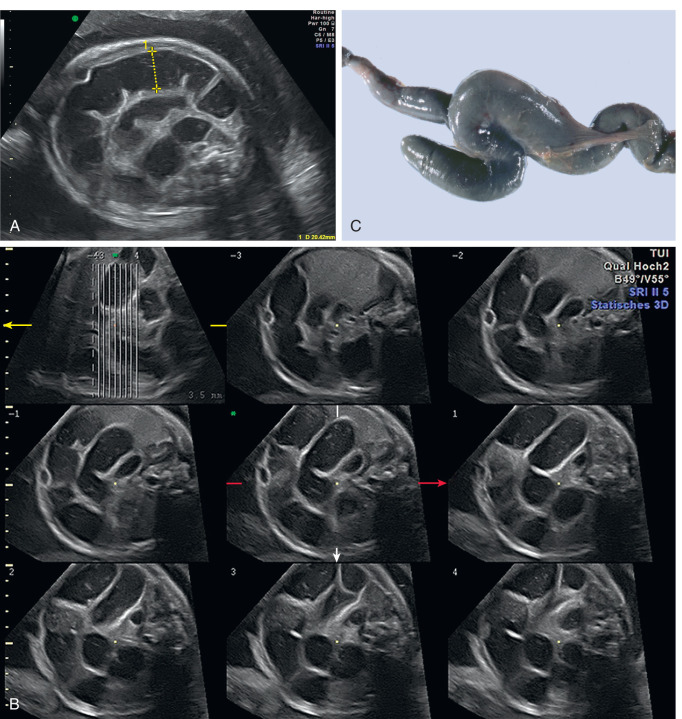
Magnetic Resonance Imaging.
The diagnosis of small bowel atresia is feasible by US, although it may be difficult to distinguish between the colon and the small bowel. With MRI, however, these intestinal parts have specific prenatal appearances. The small bowel has a hypointense signal on T1-weighted images but a hyperintense signal on T2-weighted images because the small intestine is fluid filled. The colon displays easily recognizable and spontaneous hyperintense signals on T1-weighted images and hypointense signals on T2-weighted images. With MRI, it is possible to determine the site of occlusion prenatally and to establish whether there is some remaining normal small bowel.
Differential Diagnosis From Imaging Findings
Meconium ileus, volvulus, Hirschsprung disease, hyperperistalsis syndrome, and congenital chloridorrhea should be considered in fetuses with dilated small bowel segments. Urinary tract obstruction with hydroureter and hydronephrosis can be associated with oligohydramnios, which may help distinguish it from dilated small bowel segments proximal to the atresia. Approximately one-third of prenatally recognized abdominal cysts are associated with intestinal atresia. Other cystic masses, such as ovarian cysts, enteric duplication cysts, or mesenteric cysts, have to be distinguished from small bowel atresia (see Chapter 24 ). In 27% of cases of small bowel atresia, there is an association with one of the following anomalies: volvulus, malrotation, intestinal duplications, meconium ileus, or gastroschisis. Meconium peritonitis complicates 6% of cases of atresia, and concurrent bowel abnormalities are present in 5%, including colon atresia, esophageal atresia, anorectal atresia, and enteric duplications. Even placental vascular abnormalities have been found in cases with small bowel atresia.
Synopsis of Treatment Options
The prognosis depends on the site and the extent of the atresia. In 6% of cases, ischemia and infarction lead to intrauterine perforation of small bowel and meconium peritonitis. A rare form of inherited jejunal atresia is the “apple peel” small bowel, which consists of proximal jejunal atresia with absence of the distal superior mesenteric artery, shortening of the small bowel distal to the atresia, and absence of the dorsal mesentery. The distal small intestine spirals around its vascular supply and resembles an apple peel. The result is a very short intestine with a propensity toward necrotizing enterocolitis. This defect has historically been associated with high mortality, although more recent reports suggest an improved prognosis ( Fig. 26.7 ).
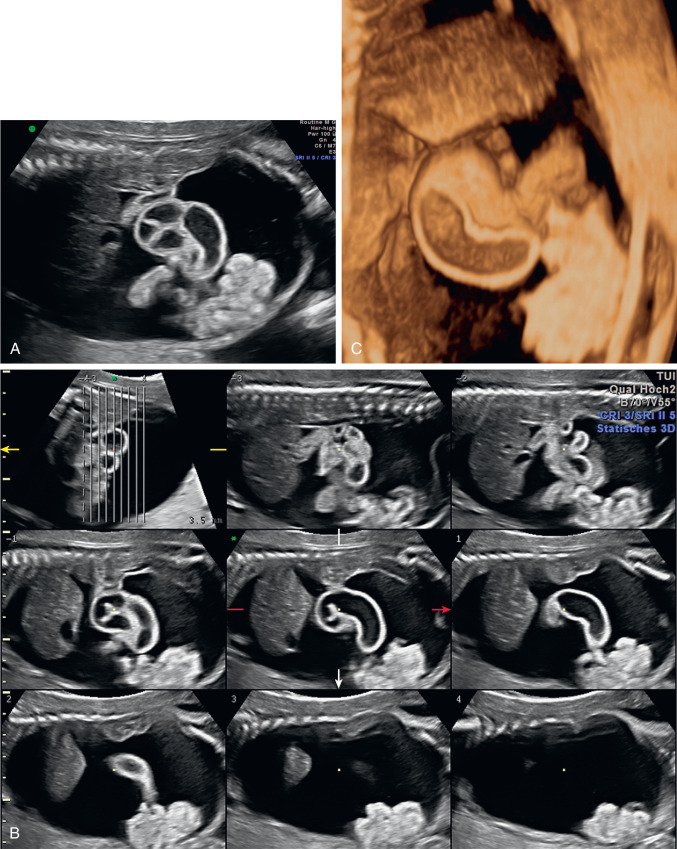
Imperforate Anus
Definition
Large bowel anomalies are rare and less frequent than small bowel anomalies. Large bowel anomalies include anorectal atresia, persistent common cloaca as a complicated form of anorectal atresia, and Hirschsprung disease. Synonyms for anorectal atresia are anal atresia and imperforate anus . In its simplest form, imperforate anus results from a failure of the anal canal to perforate during bowel development.
Prevalence and Epidemiology
The reported incidence of anorectal malformations ranges from 1 : 1500 to 1 : 5000 newborns.
Etiology and Pathophysiology
During the ninth week of gestation, the downward-growing urogenital septum separates the cloaca into the ventral urogenital sinus (which develops into the urinary bladder and urethra) and the dorsal rectum. Anorectal malformations occur by the 10th week from an abnormal partitioning of the cloaca by the urogenital septum. Imperforate anus appears if the membrane of the anal pouch does not perforate.
Anorectal malformations are classified by their termination in relation to the levator sling into high (supralevator) and low (infralevator) lesions. High lesions have a higher incidence of associated fistulas and genitourinary malformations and are more frequent.
Manifestations of Disease
Clinical Presentation
Passage of the first stool does not occur within 24 to 48 hours after birth.
Imaging Technique and Findings
Ultrasound.
The prenatal diagnosis of an imperforate anus is difficult and is seldom been made by prenatal US. Reports of prenatal diagnosis are from the third trimester; possible signs are dilated colon in the lower abdomen or intraluminal meconium calcifications proximal or distal to the site of obstruction ( Fig. 26.8 ). These calcifications differ from linear calcifications seen in meconium peritonitis, which can occur in the upper abdominal cavity, often adjacent to the liver, and sometimes are seen in the scrotum. However, more recent reports show that US findings can be observed at 12 weeks’ gestation. In the presence of associated urogenital malformations with bilateral renal obstruction, amniotic fluid can be decreased. Fetuses with imperforate anus tend to be small for gestational age. In maternal plasma, decreased alpha-fetoprotein levels have been observed in cases of imperforate anus.
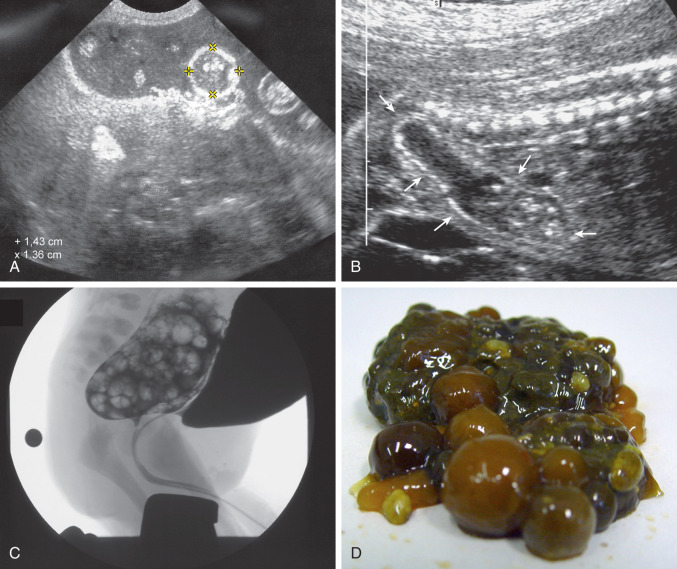
Magnetic Resonance Imaging.
MRI findings include pathologic dilatation of the distal colon and rectum.
Differential Diagnosis From Imaging Findings
Additional malformations are present in 70% of neonates with imperforate anus. When imperforate anus was diagnosed prenatally, 90% of fetuses had additional malformations, presumably making the diagnosis easier. The most common associated malformations are seen with the VACTERL association and caudal regression syndrome (renal agenesis or dysplasia, sacral agenesis, lower limb hypoplasia, sirenomelia).
Synopsis of Treatment Options
The overall prognosis of imperforate anus is poor because of the high rate of associated malformations, but the survival of infants with isolated imperforate anus and with only one additional anomaly is high. The aims of surgical treatment are to provide a normal-site anus of adequate caliber and appearance, while preserving as much of the normal intrinsic anorectal anatomy and function as possible. Posterior sagittal anorectoplasty has become the most frequently performed surgical procedure in the reconstruction of anorectal malformations, and in recent years laproscopic approaches have been developed.
Hirschsprung Disease
Definition
Hirschsprung disease, or congenital aganglionic megacolon, is a neuromotor disorder of the gut in which a failure of relaxation of bowel musculature causes a functional obstruction in the affected segment and dilatation in the segment proximal to it ( Fig. 26.9 ).
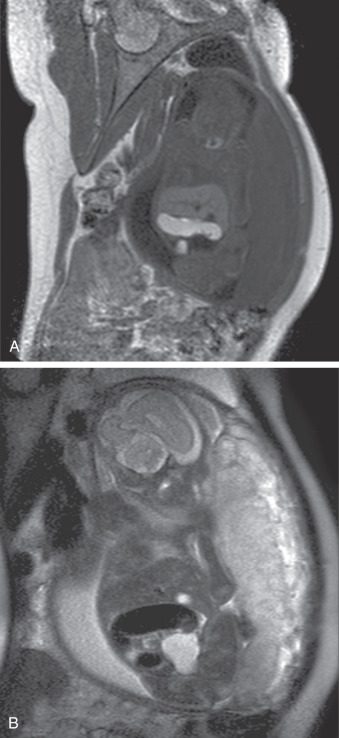

Stay updated, free articles. Join our Telegram channel

Full access? Get Clinical Tree




